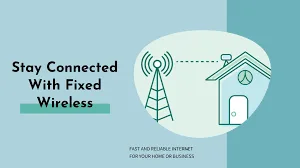
Introduction
As our world becomes increasingly connected, the demand for high-speed, reliable internet has reached an all-time high. In this digital era, fiber and fixed wireless technology are at the forefront of delivering enhanced broadband infrastructure. These technologies are revolutionizing how data is transmitted, especially when paired with edge computing innovation, which brings processing power closer to the user, enabling faster and smarter digital experiences.
This beginner’s guide will help you understand how fiber and fixed wireless technology work, how they compare, and why they’re crucial in driving the future of connectivity, particularly when integrated with edge innovations.
What is Fiber Technology?
Fiber-optic internet uses strands of glass or plastic fibers to transmit data using light signals. This method allows for:
Ultra-fast download/upload speeds
High reliability
Minimal latency
Fiber is considered the gold standard in broadband infrastructure and is ideal for heavy data tasks such as video streaming, gaming, remote work, and enterprise connectivity.
What is Fixed Wireless Technology?https://mus-tech.info/iphone-17-air-leaks/
Fixed wireless internet delivers broadband access wirelessly through radio signals from a fixed point—usually a cell tower or antenna—to a receiver installed at the user’s premises.
It is especially effective in:
Rural or underserved areas where laying fiber is too expensive
Providing fast internet in places with challenging terrain
Supporting temporary setups or mobile networks
Unlike mobile wireless, fixed wireless provides a dedicated and stable connection.
Fiber vs Fixed Wireless Internet: A Comparison
| Feature | Fiber Technology | Fixed Wireless Technology |
|---|---|---|
| Speed | Up to 1 Gbps or more | Typically up to 300 Mbps |
| Reliability | Extremely reliable | Weather can impact performance |
| Installation Cost | High initial cost | Lower infrastructure cost |
| Coverage | Limited to urban areas | Ideal for remote/rural areas |
| Latency | Very low | Moderate to low |
Both technologies serve different needs. Fiber excels in urban deployments, while fixed wireless bridges the digital divide in semi-urban and remote geographies.
Edge Computing Innovation: The Missing Linkhttps://mus-tech.info/5g-vs-6g-technology-exploring-the-future-of-mobile-connectivity-in-2025/
As connectivity evolves, edge computing is emerging as a powerful complement to both fiber and fixed wireless. Edge computing shifts data processing closer to the end user—at the “edge” of the network—rather than relying entirely on centralized data centers.
This reduces latency and enhances real-time processing for:
Autonomous vehicles
Industrial IoT
Smart homes and cities
AR/VR applications
Real-time health monitoring
By combining fiber and fixed wireless technology with edge computing, telecom providers can support next-generation applications with high performance and responsiveness.
How These Technologies Power Smart Cities
Smart cities rely on seamless connectivity and instant data exchange between devices, systems, and people. Here’s how the three innovations come together:
Fiber: Acts as the high-speed backbone
Fixed wireless: Provides last-mile delivery where fiber isn’t feasible
Edge computing: Enables rapid decision-making at local nodes
For example, in traffic management, edge devices powered by fiber or fixed wireless can analyze congestion and adjust signal lights instantly, improving urban mobility.
Role in 5G and Beyond
The deployment of 5G networks depends heavily on robust fiber and wireless infrastructure. Fiber forms the core transport for high-capacity backhaul, while fixed wireless acts as a flexible tool for small cell and mmWave coverage.
Moreover, 5G edge networks are built to reduce latency and support real-time data-intensive services. The synergy between these technologies is essential for unlocking the full potential of 5G.
Broadband Infrastructure Trends in 2025
As we move deeper into the decade, several trends are emerging in the broadband ecosystem:
Hybrid Deployments: Blending fiber and wireless for cost-effective reach
Edge-First Architectures: Deploying micro data centers near population clusters
Green Networks: Using energy-efficient infrastructure to reduce carbon footprint
Private Networks: Enterprises setting up localized networks for greater control
Open Access Models: Governments encouraging shared infrastructure to speed up deployment
These trends highlight the ongoing shift from traditional centralized models to more dynamic, edge-optimized networks.
Challenges and Considerations
Despite the promise, there are challenges:
High capital expenditure for fiber rollouts
Line-of-sight issues in fixed wireless due to obstructions
Data security and privacy risks at the edge
Need for skilled manpower to manage distributed architecture
Addressing these will require coordinated efforts from service providers, regulators, and local governments.
Who Benefits from These Innovations?https://mus-tech.info/mumbai-local-train-blasts-acquittal/
These combined technologies benefit a wide range of users:
Enterprises needing high-bandwidth, low-latency environments
Rural communities lacking fiber access
Smart home users needing seamless connectivity
Healthcare providers for remote diagnostics and monitoring
Government and public services for efficient operations